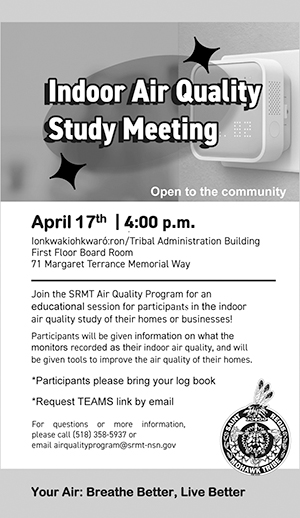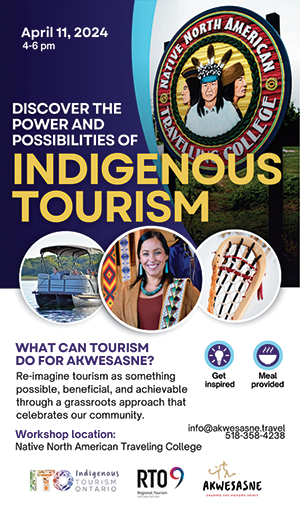Origin of the Four Sacred Ceremonies
Before the time of the Peacemaker and Hiawatha, and a time when Onkwehonwe were without spiritual beliefs and had no law to guide them- the origin of the Four Sacred Ceremonies took place.
Twelve boys were born at the same time. Eleven of the children had fathers. The one who did not have a father was born with a special power.
Because all their sons were born at the same time, the mothers of these children felt a bond with each other. Therefore, they often brought their sons together. Soon they realized that their children had a common bond among themselves. The one who had no father became the Leader. From the day he was born, there was something special about him that would attract the others. Even when they were babies playing around in the dirt, the others would go to him. He was a natural leader.
As the boys grew up, their mothers began to notice a pattern about them. They would leave the village, and go off into the woods somewhere. Finally, the mother of one of the boys began wondering about this pattern. One time she trailed them, trying to stay out of sight. She found them all sitting in a circle near a tree. To her surprise, their Leader was speaking to them. She overheard him explain that he was born into this world with a purpose. His father has sent him here to teach the people how to give thanks to their creator for a good life. She observed him speaking in a certain way. Each time he would finish, he would point to the forehead of one of the boys and say, “This is what you will be able to do”. He did this to each of the eleven boys in the circle. He would point to one of the children and say, “You will be the speaker of the Thanksgiving Greeting. This you will do to open and close each gathering. You will speak these good words on behalf of the people”. Then, to another, he would say, “You will be the singer of The Great Feather Dance. This song and dance will be the one chosen to honor the Creator and the good mind that the people have. In this manner, they will acknowledge the Creator”. To another boy, he would say, “You will be the singer of the Atonwa. This song will be used to open the ceremonies when the young ones receive their names so that all the natural life will acknowledge them and provide them with good fortune during their life cycle. This will also be the time for the men to sing their personal chants and share their song with the people”. To another he would say, “You shall learn the Drum Song which will express the appreciation of all the people for the many things they have in this world”. They would keep this going all day till close to nightfall.
When the boys returned from the forest, their Leader went to the mother and told her, “I know you came by us. I know you were out there. All I can tell you right now is that we haven’t finished our work. When that is done, we will come and explain it to the people. We will put it into words for the people to understand”.
By the time the boys were young men, they were finished with their work. They began to explain to the people what they had been learning all this time. The leader explained to the people that he had been sent here to teach people how to be grateful for all the things that we have in this world. We have to remember that all other life creatures are our relatives. They too, have a special purpose in life, and we are to respect that. The manner in which we will do this is through our songs and our dances. In this way, we will honor the things they will bring to us.
To express our appreciation for all life, I have taught my brothers three main dances, which they will teach you. These dances are: The Great Feather Dance-Otsawako:wa, The Drum Dance-Oneho:ron, and the Atonwa.
He then told the people that these dances were to be done at certain times throughout the year when the people will come together, to pay respect to life and beings that they live with and the things that keep life going. Referring to the eleven boys as brothers because they were born at the same time. He explained why all his brothers had been learning the songs and dances.
“No man will ever be able to remember all these things. Thus, they will be shared among the people, and from the people will come the next ones to learn them. So, you are to keep your eye on the little ones as they grow up because, as you do, you will see that certain ones have an interest in these things. You will see that they have the gift for picking up the songs, dances or speaking. You will watch and work with these children to teach them all these things.”
After the brothers gave their instructions to the people, they adapted these ceremonies to the cycle of the seasons:
MIDWINTER- SATEKOHSEHNE- middle of winter
MAPLE SYRUP- WAHTA-at the end of spring
THUNDER DANCE- RATIWE:RAS-early spring
STRAWBERRY- KEN NIIONHONTESHA-early summer
SEED CEREMONY- KA:NEN-early summer
BEAN CEREMONY- ORHOTSERI-midsummer
GREEN CORN- OKASERO:TA-midsummer
HARVEST- KAIENTHO KWEN ENHONTEKWARO:ROKE-fall
END OF SEASON- ONTKENHNHOKTEN-end of season
Ceremonies of Midwinter, the time when all things are new again, will remind us that we are starting a new cycle. The Thunder Ceremony will help us honor the water life. The Moon Ceremony will help us pay respect for Grandmother for working with us, for helping with the crops, for working with the female life, plant life, and the water life. Strawberry will help us pay respect to the medicine plants. Other ceremonies such as Bean and Corn will remind us that these are our main foods. The Harvest will be a celebration for our good fortune of the year. All these ceremonies will bring us closer to the Creator to remind us of our purpose in this life, and to be grateful for the things we have. The Thanksgiving Address will be spoken in these ceremonies and will bring about a better life for all the people.
At this time, the Leader told the people that he was not finished with his work. “I have to go across the salt water to bring this message to the people living over there”. Then, he took his brothers back to the spot where they had their lessons and told them “I am going to leave, and I might not come back.” He made a mark in the tree and said “If harm may come to me, my blood will flow from this tree.” And so he left.
He was gone for a long time. He was gone for so long that many of his people, many of his followers, had grown to be old men and were beginning to think that he would never come back. Finally, a sign did come. There was blood on the mark, and his brothers knew something had happened to him.
Soon after, one last person walking along the shore and looking out across the water saw a disturbance in the water. He ran to the people and started telling them that it looked like the man coming back. And the people went down to the shore and waited.
And it was him. And when he came out of the water, they could see that he had been hurt. He had been cut up. There was blood on his face. There was blood on his body.
He told the people, “Don’t touch me. They think they have killed me, but I came back. I came back to leave you one more ceremony. The Peach Bowl Game-Kaientowa:ren. I will teach you the purpose of the game and how it is played. The three other major ceremonies that you have now are for the purpose of expressing thanks to your Creator. The Peach Bowl Game will be played for his amusement. It will be played to express a good time for the people and a good time for the Creator. One of the main purposes of this game is to remind you that the things you have around you are not yours. They do not belong to you. They belong to the world. You just happen to have them around you. You just happen to have the ability to convert them with your hands into something else. So the things you have with you during your life cycle are never really yours. And the message you send back to the Creator is that “You are grateful for what you have and are willing to share with others.”
“So now you have four dances. This will be your way of thanking the Creator for all the things that he has left here on Earth for your people to live by and appreciate.”
With that the Leader left. And this is how the Onkwehonwe received their instructions in giving thanks to the Creator through the Four Dances.










Reader Comments(0)